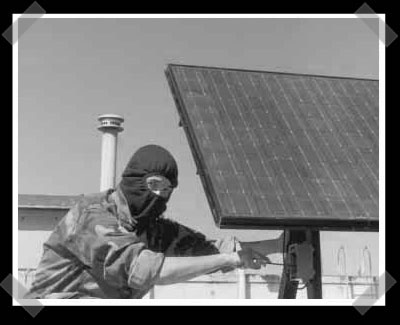Guerilla Solar
Grid-tied solar systems avoid the expense of batteries by using the power company at night, but running the electric meter backwards during the day by generating solar power from panels on the roof.
Generally, this involves permission from the power company, and permits from the local building inspectors. But many are avoiding all of that by installing the panels and grid-tied inverters by themselves, on the sly. This is usually done only with small systems, since a system actually big enough to run the meter backwards for a month will attract the attention of the meter reader. Small systems just slow the meter down by the amount they generate.

The ability to do guerilla solar installations is made much easier by the availability of small intertie capable inverters, such as the Trace Micro Sine. You connect the solar panels to the inverter, and then make a plug for the inverter (instead of a socket) so that it can plug directly into a wall socket in the house.
The inverter won't operate unless it sees a sine wave from the power company, so having a bare three prong plug hanging out won't electrocute you (besides, it's normally plugged in). This feature also protects linemen from being zapped by your solar panel when they are repairing the lines.
You can get larger inverters to support larger solar panels, and basically connect them the same way, if you are planning on generating even more electricity.
Companies like Xantrex sell grid-tie interfaces for larger inverters, to manage the syncing up to the power grid. These are generally about $400 or so.

 The ability to do guerilla solar installations is made much easier by the availability of small intertie capable inverters, such as the Trace Micro Sine. You connect the solar panels to the inverter, and then make a plug for the inverter (instead of a socket) so that it can plug directly into a wall socket in the house.
The inverter won't operate unless it sees a sine wave from the power company, so having a bare three prong plug hanging out won't electrocute you (besides, it's normally plugged in). This feature also protects linemen from being zapped by your solar panel when they are repairing the lines.
You can get larger inverters to support larger solar panels, and basically connect them the same way, if you are planning on generating even more electricity.
Companies like Xantrex sell grid-tie interfaces for larger inverters, to manage the syncing up to the power grid. These are generally about $400 or so.
The ability to do guerilla solar installations is made much easier by the availability of small intertie capable inverters, such as the Trace Micro Sine. You connect the solar panels to the inverter, and then make a plug for the inverter (instead of a socket) so that it can plug directly into a wall socket in the house.
The inverter won't operate unless it sees a sine wave from the power company, so having a bare three prong plug hanging out won't electrocute you (besides, it's normally plugged in). This feature also protects linemen from being zapped by your solar panel when they are repairing the lines.
You can get larger inverters to support larger solar panels, and basically connect them the same way, if you are planning on generating even more electricity.
Companies like Xantrex sell grid-tie interfaces for larger inverters, to manage the syncing up to the power grid. These are generally about $400 or so.